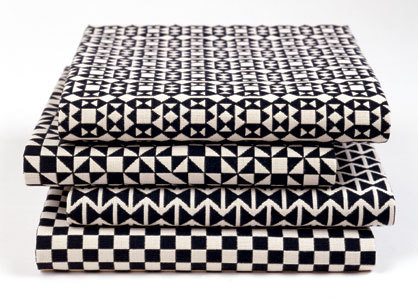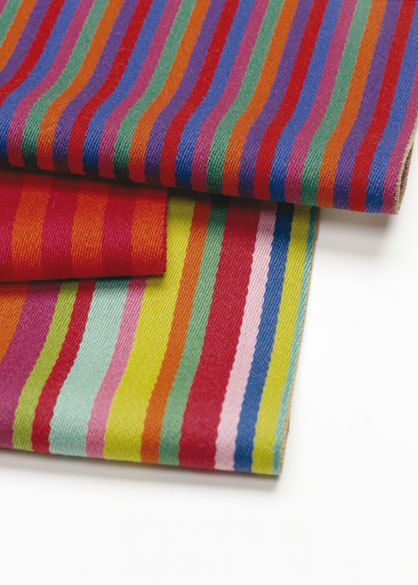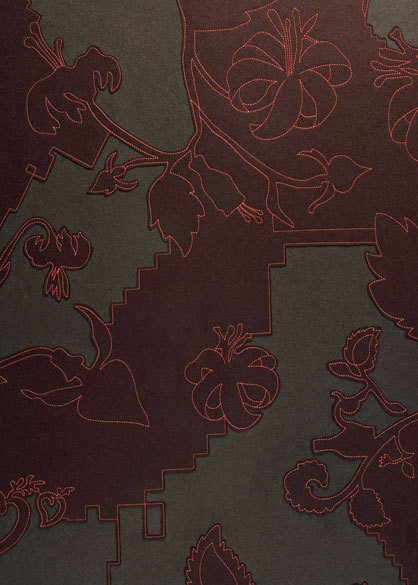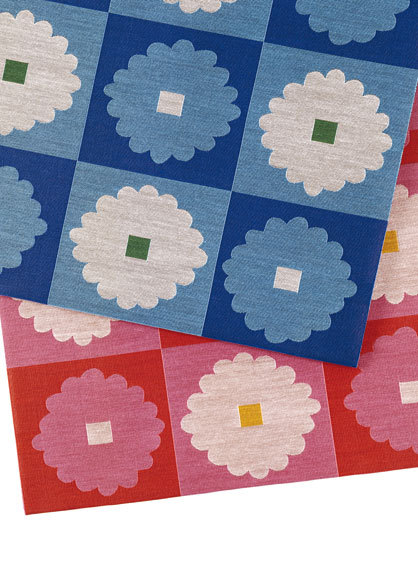Sara Sheth: Weaving Vision and Elbow Grease
Scritto da David Sokol
Washington, DC, Stati Uniti d'America
14.07.09
In a post-Milan jaunt we meet Sara Sheth, an in-house designer for the textile manufacturer Maharam
If you ever receive an invitation to explore the inner workings of Maharam’s New York headquarters, accept quickly. This all-white office space is clearly the domain of a laudable neatnik. More important, it’s a living museum of modern design, the floors studded with works ranging from Jasper Morrison’s Rietveld-simple thesis project to Rietveld’s own Zig-Zag and his lesser-heard-of Danish chair—some just objects on plinths, others readied for test drives and everyday use.
In addition to achievements of the past, a walkthrough promises a peek into designs in the making, namely Maharam textiles. Around a corner lies the company’s creative beehive, where samples and sketches spread out on white tabletops and suspend from a wall of tacks. On the day of my visit a large sheet of paper affixed with smaller pieces was fluttering lightly in the wake of passersby. Maira Kalman drawings, all of them. It’s a work in progress, and I wondered, How does a series of Kalman’s electric illustrations transform into plush, endlessly rubbed yardage?
My host explained just that. Her name is Sara Sheth, one of five members of Maharam’s in-house design team. The job is her first out of Rhode Island School of Design (from which the entire design team graduated). And her youth seems perfectly fitting for Maharam: Although founded in 1902, only recently have brothers Michael and Stephen, who took over the family business in 1997, remade its contract textiles in the image of progressive design. In addition to achievements of the past, a walkthrough promises a peek into designs in the making, namely Maharam textiles. Around a corner lies the company’s creative beehive, where samples and sketches spread out on white tabletops and suspend from a wall of tacks. On the day of my visit a large sheet of paper affixed with smaller pieces was fluttering lightly in the wake of passersby. Maira Kalman drawings, all of them. It’s a work in progress, and I wondered, How does a series of Kalman’s electric illustrations transform into plush, endlessly rubbed yardage?
My host explained just that. Her name is Sara Sheth, a self-admitted Jersey girl who is one of five members of Maharam’s in-house design team. The job is her first out of Rhode Island School of Design (from which the entire design team graduated). And her youth seems perfectly fitting for Maharam: Although founded in 1902, only recently have brothers Michael and Stephen, who took over the family business in 1997, remade its contract textiles in the image of progressive design.
Establishing that new identity first meant relying on history: Maharam’s Textiles of the 20th Century series features reissues of designs by the Eameses, Alexander Girard, Dagobert Peche, and Josef Hoffmann. Then there have been the collaborations with present-day greats, like Claudy Jongstra, Kalman, Paul Smith, and Hella Jongerius. Those new projects have yielded not just signature looks, but real innovation. For example, the Jongerius pattern Layers required four years of research before its launch. It comprises two layers of woven-wool felt embroidered together, with the negative space hand-cut from one layer; the felt is thin enough that the sandwich is still pliable. “Translating a hand process to a mechanical process can be difficult,” says Sheth, whose involvement entailed further translating Layers for use in on Nike’s Air Force. “There are very few resources in the world that can do that kind of work.”
As the office’s altar-topping collectibles suggest, Maharam pursues these projects more like passionate missions than nefarious profit makers. Sheth says, “We’re never going to be a company that thinks, ‘Ooh, he’s really up and coming, let’s work with him.’ It’s more based on intuition, and working with who we love. It might mean taking huge risks.”
That was certainly the case when Mary Murphy, who oversees Sheth and her colleagues, encountered the artwork of Brazilian Beatriz Milhazes. Upon seeing Milhazes’s super-size creations, made by applying paint to plastic and then transferring it to canvas, Murphy had “a very strong gut reaction,” Sheth recalls. Maharam signed an agreement with Milhazes, the artist’s first submission arrived at Maharam offices in August 2006, and the cotton-polyester Horto recently went on the market.
Maharam kicked off this collaboration with a few easy lessons. Milhazes traveled to headquarters to learn more about the company and past collaborations, and to field a few pointers. “With Beatriz the main thing was, as we would emphasize with any fine artist, the limitations of woven fabric—repeat limitations and color limitations, as well as the kinds of materials we can use.” Sheth adds that the artist shouldn’t feel overwhelmed. “We wouldn’t work with them if we didn’t want their points of view. It’s my job to take that artwork and make it happen.”
After Milhazes submitted her pattern in three colorways as Illustrator files, she went back to the drawing board—literally—to fill those gaps that Sheth and the other designers felt boasted too much negative space. The burden of realization then fell largely on in-house shoulders. Although originally conceived by Maharam as a tapestry, Sheth tweaked the measurements when prototype trials “sucked the life out of the artwork.” A more difficult task involved writing the color combinations for which six different yarns could create 13 colors (Milhazes submitted these colors as printouts). “The greatest challenge was to get as close as possible to the artwork in terms of color,” Sheth says. “It’s strategic, because yarns mix in such a different way than paint.”
Sheth also notes poor test results that forced changing warp construction, issues concerning color fastness, tweaking colorways according to Milhazes’s review of color trials in Rio de Janeiro—clearly, this designer does not feel stifled by realizing someone else’s vision and surmounting the obstacles involved with it. In fact, it’s just the opposite. “We’re pretty open-minded, and we don’t know where we’ll end up,” she says. “With Beatriz we even tried digitally printing on velvet to preserve the scale, color, and fluidity of her lines. I think that attitude is important, because our collaborating with someone means taking the whole journey with her, not just having an end product in mind.” And while the Maharam Design Studio has designs to call its own, such as the not-typical-for-contract nonwovens of which Sheth is particularly fond, she says that “that technical, analytical part of you” required of Maharam’s high-profile collaborations energizes her personal creativity.







